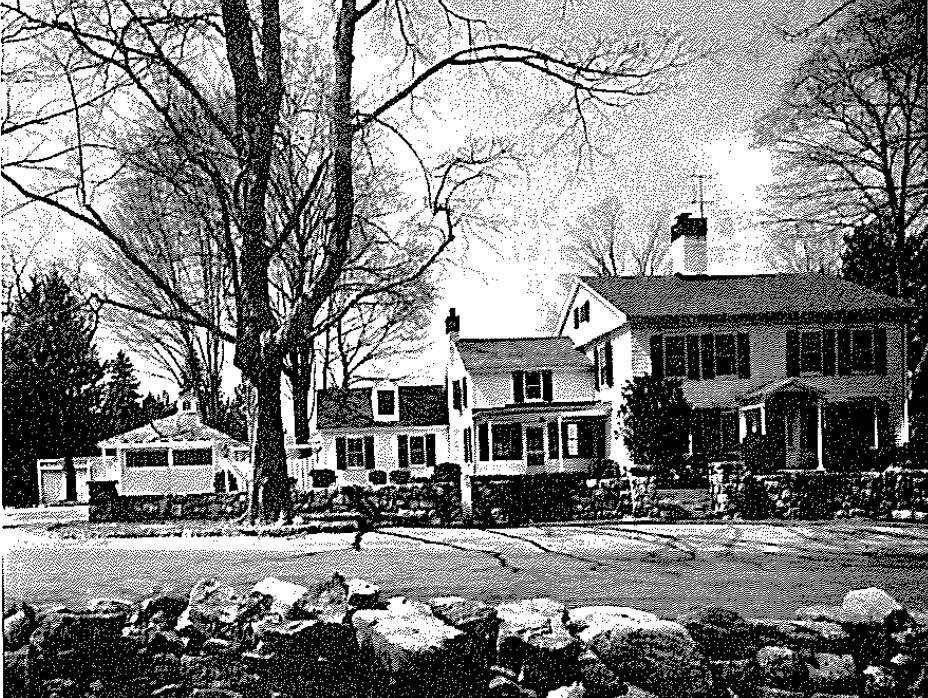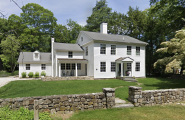634 Silvermine Road
‘New Canaan Now & Then’ is sponsored by Brown Harris Stevens Realtors Joanne Santulli, Karen Ceraso, Bettina Hegel and Schuyler Morris.
The Crofoot Ireland House located at 634 Silvermine Road has a rich history and dates back to 1800 (the New Canaan Landmarks dates it at 1796).
Silvermine in the early days was owned almost entirely by the St. John Family. In 1717, Ebenezer St. John deeded 20 acres on the east side of Canoe Hill to his son, Daniel. Seven years later, another 21 acres of land was sold to Daniel for cash. When the Daniel St. John land was divided in 1739, Daniel held the land lying immediately south of the above holdings, including the corner bounded East and South by highway which marks all the land transactions involving the corners for the next 200 years. In 1757 Daniel died and left the property to his second son, Daniel Jr. Twelve years later for eight pounds five shillings Daniel Jr. sold two acres on the north and west side of the corners to Ebenezer Crofoot, who had married his cousin Sarah St. John 20 years before.
Sarah St. John was the daughter of Jacob and Experience St. John. Joseph Crofoot came to Springfield, Mass. in approximately 1672. His son, also named Joseph, was born in 1692 and his name appears in Norwalk documents beginning in the 1720s. Joseph Crofoot married Lydia Campfield, a notable Norwalk family. The new generation of Crofoots moved to Canaan Parish in 1728 and their son, Ebenezer Crofoot, purchased a house on White Oak Shade Ridge. The Crofoots lived in New Canaan for nine years before moving to Salem, New York. It is unclear whether their son, Ebenezer, moved to Salem or stayed in New Canaan.
Ebenezer bought six acres and a dwelling across from the corners and resided there with his extended family until his son, Joseph, built the home at 634 Silvermine Road. Joseph was 25 in 1776 and married his cousin, Esther St. John on May 15, 1776 and a few months later marched off to defend the Westchester Connecticut boundary after Washington’s defeat at White Plains. His enlistment was for a month, which was the practice at the time, returning in November 1776.
His son, Ebenezer was born the following year on May 10, 1777. Joseph bought land in upper Silvermine during the 1780s and 1790s. In 1787 he bought his father’s one acre corner lot for 13 pounds. Nine years after the purchase he built what was known as the “Mansion House. It is interesting to note that prior to the building of this house, four generations of Crofoots lived at their homestead. The residents included widow Lydia Canfield Crofoot, her son Ebenezer, his second wife and daughter Polly, Lydia’s grandson Joseph and his wife Esther and their son Ebenezer Jr. and possibly even his soon to be wife Sally Gregory (he married her two years later), the eventual owners of the family homestead.
Lydia Canfield Crofoot died a year later at the age of 89. Her husband, Ebenezer Sr., appears to have moved at some point from Salem, New York to Wilton, CT. When the “Mansion House” was completed, Joseph and his wife Esther moved into the new home, which was before its time in its architecture. The home boasted 8-foot-high ceilings, four fireplaces and 24 panes of glass. The upstairs included a large hall that had four chambers. The Crofoots lived in the house for 10 years before they sold it in 1806 to their son, Ebenezer for the sum of $5. They moved to a home further up Valley Road.
Ebenezer Crofoot was known as “Captain” Ebenezer Crofoot or “Squire”. His title was not a reflection of his military rank but rather his standing in the community. When the Methodists were discriminated against and were forbidden to use the school house for their worship, Ebenezer objected. As the owner of the property where the school house stood his wishes were granted. Apparently, Ebenezer attended a Methodist service and was dramatically converted to the religion, along with his wife and daughters. Sarah Crofoot died March 29 1812 at the age of 35. Their son, Minot (born June 25, 1808), inherited the property on June 19, 1829. When he died, the property passed to his second wife, Rhuamy in 1887. It remained in the Crofoot family until 1910 when it was sold to Frank S. Dawless. When Mr. Dawless purchased the property the parcel consisted of four acres and was referred to as Crofoot Farm.
Mr. Dawless was a contractor of considerable notoriety. He built homes on Canoe Hill and was also the builder on the large addition at Ernest Greene’s Carter Street residence. Mr. Dawless served as the Justice of the Peace for the town. In March 1912 he formed a contracting partnership with Maurice Davenport. In October 1912 Mr. Dawless suggested that criminals who were currently being sent to the jail in Bridgeport could be employed to work off their sentence at the town farm, which was certainly a novel idea at the time. Mr. Dawless, his wife Elizabeth, and their two sons moved to Stamford in 1918. Mr. Dawless became involved in Stamford politics and died in 1939 at the age of 65. His wife, Elizabeth died in 1964. The Dawlesses sold the home in March 1913 to George W. Yuengling and at that time the property was recorded as six acres.
George Yuengling was born in May 1877 in Brooklyn, N.Y. He attended Princeton University and lived in New Canaan for 45 years. Mr. Yuengling owned his own insurance agency and real estate firm and was involved in many local organizations including serving as president of the Playhouse in New Canaan. Notably, he was the organizer and first president of the New Canaan Princeton Club and at his encouragement the then president of Princeton University attended the first meeting of the group.
Mr. Yuengling died in 1957 at the age of 81. In March 1935 the property was sold to Charles D. Meyer. At the time of the purchase, the land records show the property as consisting of 14.8 acres. Mr. Meyer owned the residence for less than a year before it was sold to Georgian D. Ireland (aka Jane Ireland) for $35,000. Ms. Ireland sold the property (which was now significantly reduced to 1.124 acres) to Pauline B. Park in 1950 for $44,000. Ms. Park owned the property until 1958. In 1958 she sold “1.055 acres” to Samuel M. Sipe and Elizabeth Keeney for $48,500. Mr. Sipe was born in 1916 and his grandfather was the founder of Samuel F. Sipe Diamonds in Pittsburgh Pennsylvania. He died in 2003 at the age of 87.
The Sipes sold the property to Arthur Benington and Mathilde Johnston in June 1969 for $53,000. Mr. Benington was the son of Davison Benington and Agnes Bigelow Benington. He was born in New Canaan on April 21, 1929 and lived his entire life in New Canaan. He was a partner at Alex Brown and Sons. Mr. Benington attended Westminster and graduated from Yale in 1951. He was the men’s tennis doubles champion at the Country Club of New Canaan eight different times. He died in New Canaan on November 27, 1982 at the age of 53. In 1969 the Beningtons sold the property to Wolcott and Ellen Johnson for $100,000. Mrs. Wolcott’s daughter Diana Whetstone married Robert H. Chapdelaine of New Canaan. Mrs. Wolcott died in May, 1998. The Wolcotts sold the property in September 1975 to William and Virginia Rider.
William Decker Rider and Virginia Walters Rider were married in1953 and raised three daughters in New Canaan, Southport, and Howells, New York. Mr. Rider was active in the men’s garden club and served as director for the Easter Seals Rehabilitation Center in Stamford. He died in 1996.
Mrs. Rider devoted much of her career to education. She initiated Youth Opportunities Unlimited (YOU), a project to improve the lives of underprivileged children at Bridgeport’s Waltersville School, and Father Panik Village, which became the model for the Head Start Program. She received many honors, including the Lane Bryant Award for her contributions. Mrs. Rider, who worked at the Hasting Ltd. art gallery, was also part of the group credited with the renewed interest in the WPA (Works Progress Administration”) murals in the 1990s. Mrs. Rider, an art historian, had found some of this work, much of which was done by artists from the Silvermine Art Colony, in attics and basements and conducted talks on the works for the League of Women Voters in 1996. Mrs. Rider died in 2006.
The property stayed in the Rider family until 2020 when the current owners purchased it.



Love reading the history ofmyown house! Im honored to have renovated and preserved a bit of New Canaan History!
Kristin – I have loved your house for so long! It was such a pleasure to look into it. You have done a tremendous job – I love all of the details:the porch rockers, the posters, the thoughtful balcony! You should be really proud!
Kristin, the renovation looks great!
Like the renovation to the house,but still like the way it used to look…
Great reno; much cleaner. We just took our shutters off too.
Since Ebenezer owned it, can we assume that the schoolhouse mentioned was the one room building which stood on the west side of Silvermine Rd, approximately opposite its intersection with Mill Road?
Howard – I will find out and report back.